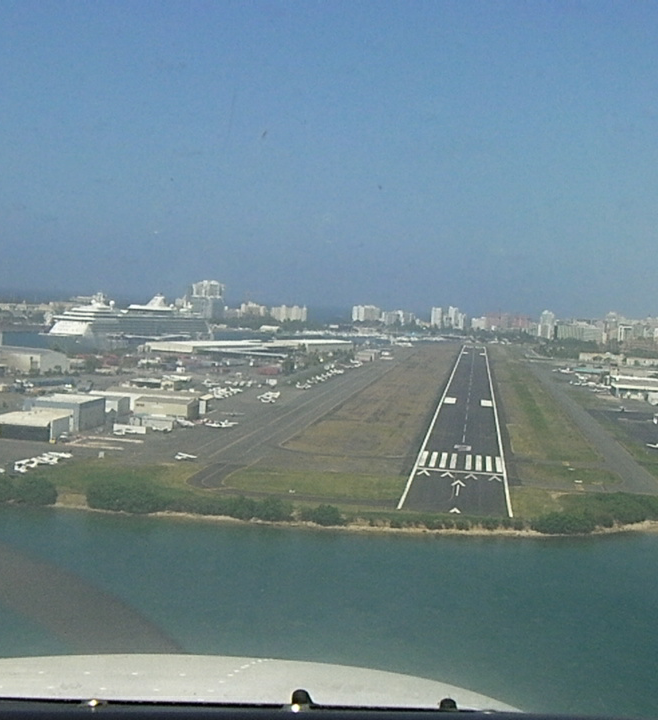


Isla Grande Flying School
& Service Corp.
787-722-1160
CESSNA 162 CHECKOUT SYLLABUS
Checkout appointment date:_________
Instructor_______________
MR./MS________________________________HAS SATISFACTORILY COMPLETED A CESSNA 162 CHECKOUT. DATE:_______________
REVIEWED BY AND CORRECTD TO 100 % BY IGFS FLIGHT INSTRUCTOR
(print)_____________________________(sign)_______________________________
A REVIEW OF THE FOLLOWING MANEUVERS & OPERATIONS ARE REQUIRED FOR AN AIRCRAFT CHECKOUT. AN INSTRUCTOR’S DECISION TO MODIFY THE LIST WILL BE BASED ON THE PILOT’S ATTITUDE, PREPAREDNESS, EXPERIENCE, CURRENCY AND PERFORMANCE.
· PREFLIGHT PREPARATION
o CERTIFICATES & DOCUMENTS
o PERFORMANCE AND LIMITATIONS
o AIRCRAFT SYSTEMS
· USE OF CHECKLISTS
o WRITTEN & MENTAL
· GROUND OPERATIONS
o PRE-FLIGHT
o COCKPIT MANAGEMENNT
o STARTING AND TAXIING
o PRETAKEOFF CHECK
· TAKEOFFS & LANDINGS
o NORMAL, SHORT & SOFT
o GO-AROUNDS
· SLOW FLIGHT AND STALLS
o SLOW FLIGHT
o POWER ON & OFF STALLS
· EMERGENCY OPERATIONS
o APPROACH & LANDING
o AIRCRAFT MALFUNCTIONS
· G300 & AVIONICS OPERATIONS
o LOGIC AND USE
o NAVIGATION
Page 1, NOVEMBER 2011
CESSNA 162 CHECKOUT EXAMINATION
THIS IS A LIGHT SPORT AIRCRAFT - DAY, NIGHT, VFR OPERATIONS ONLY
PILOT'S NAME: _______________________________________________ DATE: ____/____/____
ENGINE (1) Manufacturer and type: _____________________________ Horsepower: _________________
(2) If the optional fuel primer control is not installed, how is engine priming accomplished? ________
_____________________________________________________________________________________
ENGINE POWER SETTINGS (3) Run-up: ____________________ Takeoff: _____________________
Maximum % continuous power: ___________________________ Climb: ________________________
Cruise, 75% power (4), 4,000 feet, standard temperature: RPM________ GPH________ KTAS_____
Cruise, 55% power (5), 6,000 feet, standard temperature: RPM________ GPH________ KTAS_____
OIL (6) Grade: __________ wt. Max. indicated quantity: ____ qts. Min. indicated quantity: ____ qts.
FUEL (7) Grade: _________________ Color: _____________________ Number of fuel tanks: ________
Total capacity: ______gal. Useable: ______gal. (8)Tank tab indications: _____;_____;_____;_____
(9) Take off prohibited with less than ________ fuel.
(10) Location & number of all fuel drains: __________________________________________________
_____________________________________________________________________________________
(11) How are the fuel tanks vented: _______________________________________________________
_____________________________________________________________________________________
(12) How does fuel get to the carburetor: __________________________________________________
(13) Describe the cockpit fuel indicating system: __________________________________________
_________________________________________________________________________________
(14) Does the cockpit
indicator accurately show full fuel: _____ What does:_____________________
Page 2, NOVEMBER 2011
CESSNA 162 CHECKOUT EXAMINATION
WEIGHTS (use information manual values, actual aircraft weight, moment and cg will vary)
(15) Maximum taxi: ____________ lbs. Maximum gross take off & landing: _______________ lbs.
Empty: ____________ lbs. Useful load: _____________ lbs.
(16) Full fuel pay load:__________ Half fuel pay load:________ Baggage limit_____________
AIRSPEEDS (KIAS ) (17) Vx ______kts. Vy ______ kts. Cruise climb __________ kts.
VA ______ kts. Design Maneuvering Speed - No abrupt control movements above this speed.
Does VA provide protection from possibly overstressing the airplane: _____________
Vo 1320 lbs__________1200 lbs__________1100 lbs__________ Maximum Operating Maneuvering Speed – Speed at which the airplane may be stalled with out exceeding structural limitations.
VNO ______ kts. VNE ______ kts. Vs ______ kts. VSO ______ kts.
Best glide ______ kts. VFE 10°_______ 25°________Full___________ kts.
(18) Final approach: Flaps up ________ kts. Flaps full down ________ kts. Short/Soft field ________ kts.
SERVICE CEILING (19) _____________ ft.
ELECTRICAL SYSTEM (20) Battery voltage ________ Bus voltage range _______________
Use of MAIN CB RESET button ______________________________________________________
_______________________________________________________________________________
ELT – (21) Location of unit and remote switch:______________________________________________
____________________________________________________________________________________
____________________________________________________________________________________
DOORS (22) Can the doors be open for start and taxi:_____ For run-up: ______ In flight:________
Page 3, NOVEMBER 2011
CESSNA 162 CHECKOUT EXAMINATION
CARBURETOR ICING – (23) Describe indications of carburetor icing and use of carburetor heat________
_____________________________________________________________________________________
_____________________________________________________________________________________
PITOT AND STATIC SYSTEM – (24) Location of pitot tube, is it heated and location of static vent:
_____________________________________________________________________________________
BRAKE SYSTEM – (25) Describe system, including location of reservoir:___________________________
_____________________________________________________________________________________
_____________________________________________________________________________________
G300 SYSTEM (26) Can the G300 be used for pilotage navigation or terrain/obstacle avoidance: ________
COMPUTATIONS
1. (27) 1,320 pounds, 50 foot obstacle, 4,000 foot pressure altitude, 40 degrees C
a. Take off distance ___________
b. Landing distance ___________
c. Best rate of climb ___________
Page 4, NOVEMBER 2011